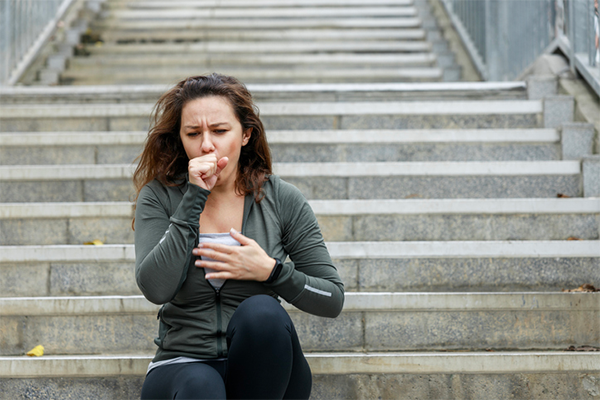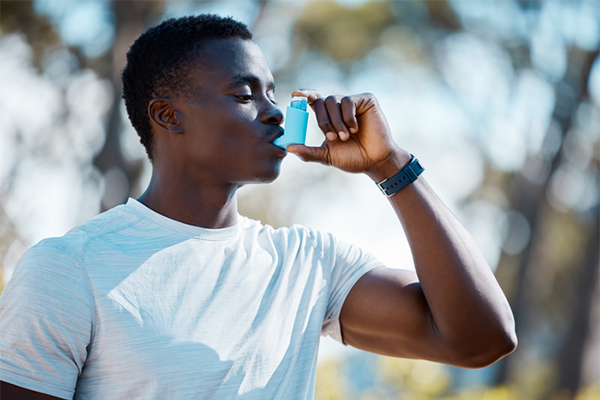For most of the approximately 262 million sufferers of asthma worldwide, one particularly vexing manifestation of the disease is exercise-induced asthma, also known as exercise-induced bronchoconstriction (EIB) — asthma symptoms brought on by physical exertion.
And even for many who don’t suffer from chronic asthma, EIB is a persistent problem, which poses a conundrum: Your cardiovascular system needs exercise to stay healthy, but how do you work out when just a few minutes of exertion make you short of breath?
What Is “Exercise-Induced Asthma?”
Exercise-induced bronchospasm or bronchoconstriction — the terms preferred over “exercise-induced asthma,” which could be interpreted by some to mean that exercise causes chronic asthma — is a respiratory response with asthma-like symptoms that typically flares up after four to six minutes of moderately vigorous exercise.
As dry, cool, unfiltered air fills the lungs, the muscles surrounding the bronchial tubes contract, resulting in a tight feeling in the lungs, and particular difficulty expelling air. A bad case feels like you’re trying to breathe through a cocktail straw.
How Do You Know if You Have Exercise-Induced Bronchoconstriction?
Exercise-induced bronchospasm can be surprisingly tough to detect: “Sometimes, it flares up in people who don’t experience asthma symptoms at any other time,” says sports medicine physician Jordan Metzl, author of The Exercise Cure: A Doctor’s All-Natural, No-Pill Prescription for Better Health and Longer Life.
Affecting up to 20 percent of those without asthma, EIB can also masquerade as low fitness. Though some people experience the wheezing and coughing typical of other types of asthma, others who suffer EIB simply experience low stamina or difficulty recovering from exercise.
Fortunately, most cases of exercise-induced bronchoconstriction fall under the heading of “inconvenient” rather than harmful — to make it go away, you just have to stop exercising. Still, EIB can put a serious crimp in your workouts if you leave it untreated.
Symptoms of EIB
Those suffering exercise-induced bronchoconstriction may experience one of all of the following:
- Wheezing
- Coughing
- Tightness in chest
- Shortness of breath
- Low stamina
- Fatigue
6 Ways to Help Prevent Exercise-Induced Bronchospasm
If you experience any EIB symptoms, see a doctor — and discuss these guidelines:
1. Avoid the wrong types of exercise
If you’re prone to exercise-induced bronchoconstriction, workouts that require constant activity, like soccer, basketball, and long-distance running, are more likely to bring on symptoms than those requiring short bursts of activity. And aerobic exercise in cold, dry air, such as cross-country skiing and ice skating can be worst of all.
Your best strategy for staying fit, then, is start-stop exercise, such as strength training, sprints, and tennis. Another great option for people with EIB is swimming: the vapor near the water’s surface humidifies the air and reduces your chances of an episode.
2. Warm up
You’re doing this anyway (right?), but if you’re susceptible to exercise-induced bronchoconstriction you have yet another reason to take 5 to 10 minutes to perform active stretching and low-intensity movement (at about 60 percent of maximum effort) before jumping into the “meat” of your workout.
Warming up properly should keep you free of inflammation for about an hour — plenty of time to get in a good workout.
3. Medicate judiciously
If your doctor confirms you’re prone to EIB, you might be prescribed a fast-acting rescue inhaler. “Take it 15 minutes before you exercise,” says Metzl. “And keep it handy during your workout.”
You may also be given other medications, such as an inhaled corticosteroid, to take at other times — even if you aren’t experiencing symptoms. Don’t skip them.
4. Modify your breathing
Clinicians have theorized that mouth-breathing — which allows cool, dry air to enter the lungs — may be a major cause of exercise-induced bronchospasm. In one study, EIB-prone subjects instructed to breathe through their noses during exercise experienced none of their usual symptoms.
Nose breathing during hard exercise can be impractical — but if you feel tightness of EIB coming on, along with other measures, it may help to mitigate your symptoms.
5. Know your triggers
Dust, mold, and animal dander are mortal enemies of many asthma sufferers, so they should be avoided during exercise. Others might have problems with humidity, grass, smog, and other outdoor irritants.
If you know what your triggers are, take steps to avoid them. Indoor workouts may be your best bet, especially during allergy season.
6. Don’t let it slow you down
A 2015 study found that regular exercise helped reduce the severity and frequency of asthma episodes in people with the condition. So rather than letting exercise-induced bronchoconstriction slow you down, let it motivate you to exercise even more diligently.
Using the five strategies above, you should able to exercise frequently and intensely enough to substantially reduce — or even eliminate — your symptoms.
The post Prevent “Exercise-Induced Asthma” With These 6 Tips appeared first on BODi.





0 Comments